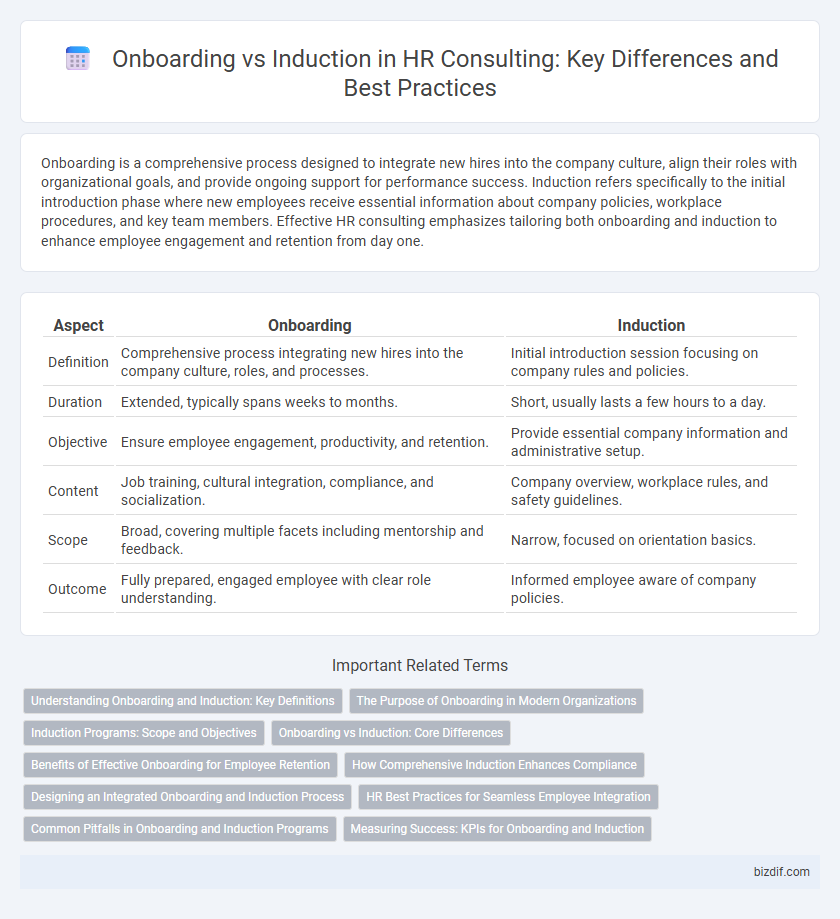Onboarding is a comprehensive process designed to integrate new hires into the company culture, align their roles with organizational goals, and provide ongoing support for performance success. Induction refers specifically to the initial introduction phase where new employees receive essential information about company policies, workplace procedures, and key team members. Effective HR consulting emphasizes tailoring both onboarding and induction to enhance employee engagement and retention from day one.
Table of Comparison
| Aspect | Onboarding | Induction |
|---|---|---|
| Definition | Comprehensive process integrating new hires into the company culture, roles, and processes. | Initial introduction session focusing on company rules and policies. |
| Duration | Extended, typically spans weeks to months. | Short, usually lasts a few hours to a day. |
| Objective | Ensure employee engagement, productivity, and retention. | Provide essential company information and administrative setup. |
| Content | Job training, cultural integration, compliance, and socialization. | Company overview, workplace rules, and safety guidelines. |
| Scope | Broad, covering multiple facets including mentorship and feedback. | Narrow, focused on orientation basics. |
| Outcome | Fully prepared, engaged employee with clear role understanding. | Informed employee aware of company policies. |
Understanding Onboarding and Induction: Key Definitions
Onboarding is a comprehensive process aimed at integrating new employees into the company culture, policies, and role expectations over an extended period. Induction specifically refers to the initial orientation session introducing new hires to basic organizational procedures and workplace environment. Understanding the distinction between onboarding and induction enables HR professionals to design effective integration strategies that enhance employee engagement and retention.
The Purpose of Onboarding in Modern Organizations
Onboarding in modern organizations focuses on integrating new employees through personalized experiences that align with company culture, values, and role expectations. It enhances employee engagement, productivity, and retention by providing ongoing support, training, and feedback beyond initial orientation. This strategic process helps build long-term commitment and accelerates the time-to-competency for new hires.
Induction Programs: Scope and Objectives
Induction programs in HR consulting are designed to familiarize new employees with organizational culture, policies, and workplace expectations, ensuring swift integration. These programs focus on delivering essential information about company values, job roles, and compliance requirements to enhance employee engagement and reduce early turnover. Effective induction programs improve job performance by providing a structured introduction that aligns new hires with strategic business goals.
Onboarding vs Induction: Core Differences
Onboarding integrates new employees into an organization by aligning them with long-term roles, culture, and goals over weeks or months, while induction is a short, initial orientation focused on basic company policies and immediate job duties. Onboarding encompasses training, socialization, and performance expectations, whereas induction primarily addresses administrative tasks and workplace introductions. Effective onboarding leads to higher retention and productivity, whereas induction serves as a preliminary step in employee assimilation.
Benefits of Effective Onboarding for Employee Retention
Effective onboarding significantly improves employee retention by fostering early engagement and reinforcing commitment to company values. Structured onboarding programs accelerate new hires' productivity, reduce turnover rates by up to 60%, and enhance overall job satisfaction. Consistent onboarding processes create a supportive work environment that promotes long-term loyalty and reduces recruitment costs.
How Comprehensive Induction Enhances Compliance
Comprehensive induction programs ensure new employees fully understand company policies, legal regulations, and role-specific compliance requirements. This structured approach reduces the risk of non-compliance by clearly communicating standards and expectations from day one. Effective induction accelerates adherence to regulatory frameworks, fostering a culture of accountability within the organization.
Designing an Integrated Onboarding and Induction Process
Designing an integrated onboarding and induction process enhances employee engagement by seamlessly combining orientation, role-specific training, and company culture immersion. Effective integration reduces time-to-productivity and improves retention by providing clear expectations and continuous support from day one. Leveraging digital platforms and personalized content tailors the experience, ensuring alignment with organizational goals and employee development needs.
HR Best Practices for Seamless Employee Integration
Onboarding encompasses comprehensive HR best practices designed to integrate new employees into company culture, roles, and workflows effectively. Induction focuses specifically on initial orientation activities such as compliance training, introductions, and basic administrative procedures. Optimizing both processes enhances employee engagement, reduces turnover, and accelerates productivity by ensuring seamless integration from day one.
Common Pitfalls in Onboarding and Induction Programs
Common pitfalls in onboarding and induction programs include lack of clear objectives, inconsistent communication, and insufficient employee engagement. Organizations often overlook personalized onboarding experiences, resulting in reduced new hire productivity and retention. Ensuring structured processes and continuous feedback significantly enhances the effectiveness of both onboarding and induction initiatives.
Measuring Success: KPIs for Onboarding and Induction
Measuring the success of onboarding and induction programs involves tracking key performance indicators (KPIs) such as employee retention rates, time-to-productivity, and new hire satisfaction scores. Effective onboarding KPIs include the percentage of new hires completing training within designated timeframes and engagement levels during the first 90 days. Induction success is often assessed through feedback surveys, compliance adherence rates, and early performance evaluations to ensure seamless integration into company culture and processes.
Onboarding vs Induction Infographic

 bizdif.com
bizdif.com